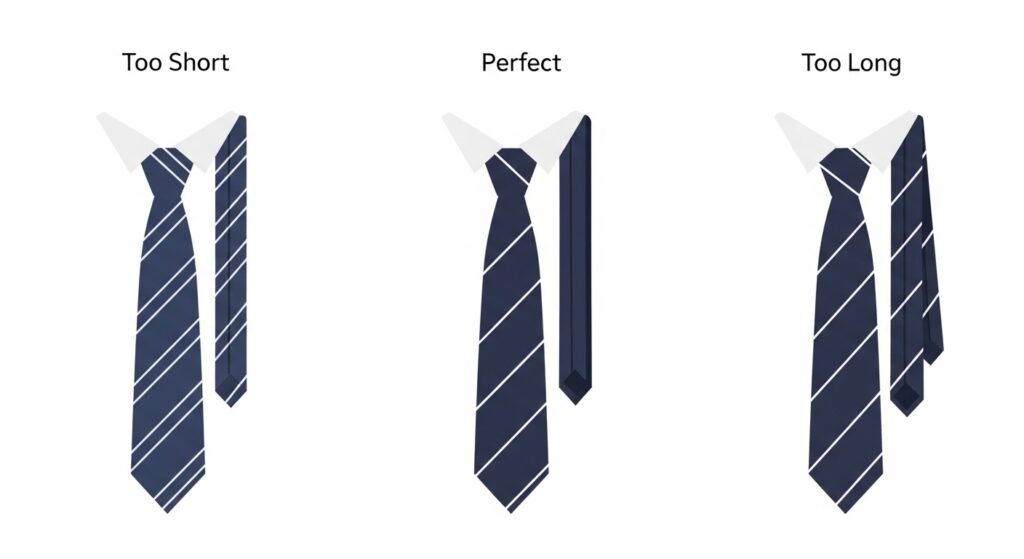In today’s fashion-conscious world, presentation is power. Whether in the boardroom, at a wedding, or during a first impression, the smallest details can shape perceptions of confidence, precision, and professionalism. Among those details, one deceptively simple question often defines the line between polished and careless: how long should a tie be?
Far from a trivial style concern, tie length reflects one’s understanding of proportion, attention to detail, and self-awareness. The right tie length doesn’t just complete an outfit—it communicates discipline and confidence, quietly setting the tone for how you’re perceived.
This article explores the enduring rule of tie length, why it matters, how it varies by body type and occasion, and how mastering this simple principle can transform your appearance from average to exceptional.
The Classic Rule: Where Should a Tie End?
When it comes to tie length, tradition offers one clear standard: the tip of your tie should rest at the middle of your belt buckle.
It’s that simple. When standing straight, the tip should just graze the belt buckle—not higher, not lower.
Here’s what that means in practice:
-
Too short: The tie ends above the belt line, making your torso appear broader and your outfit unfinished.
-
Too long: The tie extends past your belt, causing imbalance and untidiness.
-
Just right: The tip reaches the middle of your belt buckle—clean, classic, and universally flattering.
This single rule—often overlooked—creates harmony between the upper and lower halves of your body, producing the kind of visual balance associated with timeless style.
Why Tie Length Matters
The question “how long should a tie be” goes deeper than aesthetics. In fashion, small choices reflect personal discipline, attention to detail, and self-respect.
A properly tied tie conveys precision and order—qualities that translate naturally into professionalism. Even the most expensive suit loses its impact if the tie hangs awkwardly or ends too high. Conversely, a correctly measured tie instantly signals care, competence, and confidence.
Tie length, then, becomes more than a style preference—it’s a symbol of proportion and respect, both for oneself and for the setting.
Adapting the Rule: Body Type and Proportion
While the belt-line rule applies universally, your height and body shape determine how to achieve that ideal proportion.
1. For taller men (6 feet or more):
Standard ties (57–58 inches) may fall short. Choose extra-long ties—typically 61–63 inches—to ensure proper length after knotting.
2. For shorter men:
A standard tie will often suffice, but avoid bulky knots like the full Windsor, which shorten visible length. A four-in-hand knot offers balance and a cleaner finish.
3. For broader builds:
A slightly longer tie with a medium-width knot helps maintain visual symmetry and elongates the torso.
4. For slimmer frames:
Slim ties with narrower knots (like the half-Windsor) maintain proportion with smaller lapels and lean silhouettes.
Mastering how long a tie should be means understanding that proportion isn’t one-size-fits-all—it’s about tailoring the rule to your physique.
The Knot Factor: How Different Knots Affect Length
The type of knot you choose plays a surprisingly important role in determining tie length. Each knot consumes a different amount of fabric.
Here’s a quick guide:
-
Windsor Knot: Large, formal, and symmetrical, but uses the most length. Ideal for long ties or shorter torsos.
-
Half Windsor: Balanced and moderately full. Perfect for most body types and formal settings.
-
Four-in-Hand: Slim and slightly asymmetrical; uses minimal fabric, making it ideal for taller individuals.
-
Pratt Knot: Mid-size and versatile, offering symmetry without consuming excessive fabric.
When experimenting with knots, always check your final tie length before leaving the mirror. Even the most elegant knot loses its charm if the tie hangs too long or too short.
The Psychology of Precision
Why does tie length matter so much? Because precision communicates competence.
Fashion psychology suggests that well-balanced attire enhances confidence—not just how others perceive you, but how you feel about yourself. Getting the length right demonstrates care and composure—traits valued across every professional and social setting.
When someone asks, “how long should a tie be?” they’re really asking: how can I appear balanced, composed, and credible? The answer lies in proportional mastery.
Modern Interpretations: Tradition Meets Style
Fashion evolves, and so do interpretations of timeless rules. While the belt-buckle guideline remains the standard, modern style occasionally bends it:
-
Casual looks: A slightly shorter tie can appear relaxed when paired with unstructured blazers or denim.
-
High-fashion statements: Some designers intentionally elongate ties for runway dramatics or asymmetrical flair.
-
Streetwear adaptations: Looser, slightly longer ties can add rebellion and edge in fashion-forward ensembles.
However, for business and formal settings, it’s best to stay true to the classic rule. Knowing how long a tie should be gives you the freedom to experiment—because mastery always precedes innovation.
Common Mistakes to Avoid
Even confident dressers occasionally miscalculate tie length. Here are pitfalls to watch out for:
-
Ignoring body proportions. A tie that fits one person perfectly might overwhelm or underwhelm another.
-
Choosing the wrong knot for your height. Larger knots shorten your tie—plan accordingly.
-
Neglecting posture. A tie that’s “perfect” when slouching may look off when standing upright.
-
Overlooking belt placement. Low-rise trousers or high-waisted pants shift the tie’s endpoint—adjust accordingly.
Take a moment before leaving the mirror to check your alignment. That extra second often separates polished from careless.
How to Test Your Tie Length Quickly
Here’s a simple test:
-
Stand tall with your arms relaxed.
-
Look at your belt buckle.
-
The tip of the tie should meet its midpoint—not cover it, not hover above it.
If you plan to sit often (such as during meetings), tie your knot slightly shorter—ties naturally lift a bit when seated.
The Deeper Message Behind the Detail
Ultimately, understanding how long should a tie be is about more than fabric and fashion. It’s about self-respect, intention, and excellence in the smallest acts.
Much like leadership, style isn’t defined by what’s loud or visible—it’s defined by what’s precise, consistent, and considered. A perfectly measured tie reflects not vanity, but mindfulness—a quiet discipline that leaves a lasting impression.
In a world where trends come and go, mastering timeless details like this ensures your style remains relevant, refined, and unmistakably confident.
Looking Ahead: Timeless Elegance in a Modern World
Trends may shift, but good taste endures. The simple rule of proper tie length—belt-line precision—has survived decades of changing fashion. Why? Because it’s rooted in proportion, the foundation of all great design.
So, the next time you stand before the mirror, ask yourself not just how long should a tie be, but what does this say about me? Because the tie, though small, can symbolize something profound: balance, intention, and mastery of the details that matter most.







